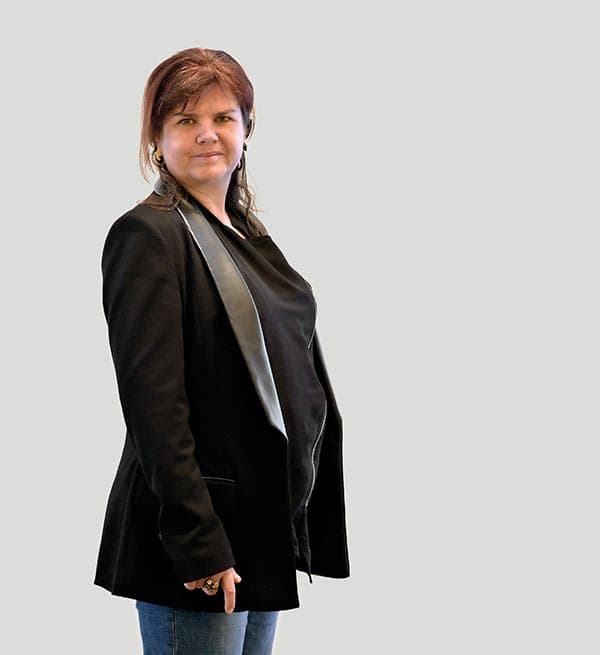
Karla Dickens
Learning resource
Rising Passion
Karla Dickens
Wiradjuri people
born 1967 Sydney, New South Wales
lives and works Lismore, New South Wales
Speak your mind
Talking points or provocations to unpack the works through discussion and/or contemplation:
- Through her arts practice Karla Dickens has found a platform for her opinions and points of view. Discuss how creativity can be used as a tool of empowerment for the individual and also for marginalised groups within the wider Australian society.
- Dickens is a proud Wiradjuri women living on the traditional lands of the Bundalung nation in Lismore on the north coast of New South Wales. How might living within a small regional community influence her work and choice of materials?
- Justice can mean different things to different people. Do you agree with this statement? How might an Indigenous perspective of justice and history differ from a non-Indigenous perspective?
- Since childhood Dickens has been collecting objects at markets, op shops and rubbish tips. She enjoys these objects for their history and story and some of them become art materials that she uses to create her works of art. Do you like buying second-hand objects and even upcycling or restoring them?
- As Dickens says ‘One man’s waste, is another woman’s treasure’. What do you think of this statement?
Senior options
- Dickens is deeply connected to her Indigenous heritage and also to her status as a woman living in contemporary society. Her experience as a single mother and as a lesbian gives her a complex perspective on our society and the treatment ascribed by society to different groups. Can you think of ways that different people or cultural groups are treated in your local community or even within the school environment?
- The use of upcycled materials can be a cheap way of making art. What do you think are the benefits and drawbacks to using found objects in the creation of a work of art? Do upcycled items come with an inherited meaning or context and if so how might that be enhanced or subverted?
- What does protest mean to you and how do you choose to voice your opinions? It could be online, through attending rallies and marches or even through your consumer choices. What rights does the individual have to make political statements without fear of persecution?
- What is post-colonialism? Are we living in a post-colonial society?
Get to work
Creative making suggestions that highlight key concepts:
- Objects have a history and a story that is often evident when you take the time to examine its form and marks from use. Find an object from your home that you are familiar with and examine it with new eyes. Ask members of your family what they have used the object for and their memories of it. Create a drawing of the object as it is now surrounded by a selection of images depicting its journey. You may like to emphasise the individual qualities of this object in contrast to other items of the same variety.
Extension: Write a short poem to describe the life of this object. Draw up a timeline that details the life of the object in relation to important moments of Australian history. Was the item around to witness the 1967 Referendum?
- Op shops, markets and second-hand stores can be a rich source of inspiring and unique art materials, from fabrics and crafty elements to vintage books and images. Create a sculpture of 2D work from a found collection of objects. Think about colour, form and texture and how your found objects might contrast or work in harmony with each other. You may want to use glue, wire or even wool and fibre in the creation of your work.
Extension: Think about the meaning of each object and how that might vary within different individuals or groups. Some objects have the additional layer of brand added into their meaning, which can signify different things. How might you incorporate symbols and signs like brands into a work of art?
Think it through
Ideas to aid you in the creation of works:
- Where can you source second-hand items in your community?
- What are the Indigenous language groups where you live? Do the Indigenous people of your area use different names for local landmarks or places?
- Do you know many places in regional Australia? Locate the Northern Rivers region and Lismore. Where are the traditional lands of the Wiradjuri people?
Senior options
- Lismore and the Northern Rivers have a long tradition of active community protest and political commentary. What are the big issues that people are concerned about in your area?
- The use of found objects as materials for works of art has a long and rich history. The national collection holds many works of assemblage created by artists from all over the world. Visit the NGA website and find a work of art that uses an upcycled or found object. Some artists of note to search for include Marcel Duchamp, Pablo Picasso and Rosalie Gascoigne AM.
Places to go
Links for more information about the artist:
- Artist’s website
- Design & Art Australia Online
- Artlink
- Museum of Contemporary Art
- SBS On Demand
- Andrew Baker Gallery
Talk the talk
Glossary of words in the education resource and artist statement:
- marginalised: treat (a person, group, or concept) as insignificant or peripheral
- upcycling: reuse (discarded objects or material) in such a way as to create a product of higher quality or value than the original
- post-colonialism: of, relating to or being the time following the establishment of independence in a colony
- protest: a statement or action expressing disapproval of or objection to something
- emphasis: special importance, value, or prominence given to something
- signify: be an indication of
- subverted: to change or reverse a meaning
Search for works by this artist in the national collection.